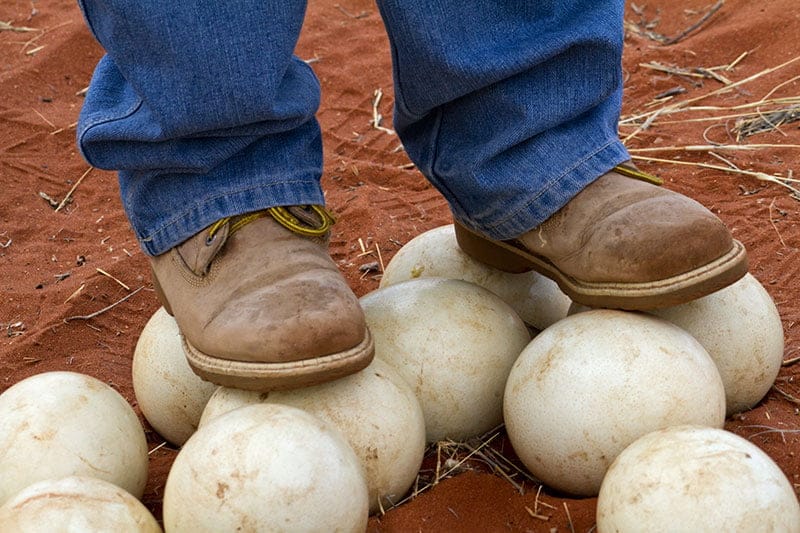Main Menu

The largest living bird in the world and also the heaviest is the common ostrich (Struthio camelus), usually known simply as the ostrich.
It is one of only two species of extant ostrich, the other being the Somali ostrich (Struthio molybdophanes) which until 2014 was considered a subspecies of the ostrich.
It is endemic to Africa found in dry, open habitats, such as savanna, semi-deserts, and scrubland. It has a wide distribution from the southern coastline of the Cape of South Africa to south of the Sahara Desert in North Africa. However, as it does not inhabit areas that are densely vegetated there is a break in its distribution, and it is not found in much of western and central Africa.
Ostriches are also found in Australia but these are not native. In the 1970s attempts were made to farm them for feathers and meat but they mostly failed, and the birds were either released or escaped into the wild. Today many feral ostriches roam the Australian outback able to survive because the climate and dry habitat is similar to Africa’s.
The ostrich is a distinctive looking bird with a long neck and legs and flat, rounded body. The male has black plumage with white outer wing feathers and a white tail. The grey or pink head and neck is almost bare covered with a thin layer of down, and it has a broad, flat beak with a rounded tip. The legs are bare except for the lowest part which is covered in red scales.
The female has grey-brown and white plumage with a bare pink head and neck also covered in fine down. The scales on the legs are black.
On average, male ostriches are between 2.1 and 2.75 m tall and weigh 100 to 130 kg. Females are about 1.75 to 1.9 m tall and weigh between 90 to 120 kg. However, some males can weigh up to 156 kg while there are some individuals in South Africa that weigh just 60 kg.
The ostrich is flightless although it descended from a flying bird. Despite this it still has wings that can span up to 2 m, which is comparable with the size of the wings of the largest flying birds such as swans, condors, and bustards.
Its wings serve a number of functions such as stability and enhanced manoeuvrability when running, It also uses its wings to cover the bare skin of the top of its legs and flanks to help it keep warm.
Ostriches differ from most other species of birds in several ways. For example, it has no crop or gall bladder, and the male has a penis. Its pubic bones are fused together to hold in its guts and unlike all other birds it stores and secretes its urine and faeces separately.
As well as being the biggest bird in the world, the ostrich holds several other avian records.
The ostrich has the largest eyes of all living land animals. The diameter measured from the centre of the cornea at the front of the eye to the centre of the retina at the back is about 50 mm which is about twice the size of a human eye and bigger than the bird’s brain.
To help protect the eye from dust and sand the ostrich has long eyelashes that also shade it from sunlight above. When it closes its eyes, the bottom eyelid moves upwards and they have a nictitating membrane that sweeps across the eye to keep it clean and moist.

The ostrich’s huge eyes mean it has excellent eyesight and coupled with its height enables it to see as far as 3.5 km away during the day and up to 50 m at night, essential for spotting potential predators such as lions from a safe distance.
The high number of photoreceptors in the retina of the ostrich eye combined with the size of the image produced by the lens means that it is associated with high sensitivity rather than high resolution. Although the ostrich isn’t nocturnal, the structure of its eye supports the theory that large eyes tend to be associated with nocturnality in which high sensitivity is more important than spatial resolution. If its eye was any larger though, the image would be distorted.
Largest egg
The ostrich lays the largest eggs of all living birds, although the smallest relative to its body weight. On average they are 15 cm long, 13 cm wide and weigh 1.4 kg which is about 20 times the weight of a chicken’s egg.
The variation in feather colour between males and females mean that the female incubates them during the day when her brown plumage blends into the sand, and the male incubates them at night when his dark plumage makes him almost invisible to predators. Despite this camouflage, ostrich eggs have a high rate of predation and the incubation period is only about 40 days which is short compared to other ratites. Emus, for example, incubate their eggs for up to 56 days.

The eggshell is about 3.5 mm thick and is strong enough to support the weight of up to 220 kg which means most people can stand on an ostrich egg without it breaking.
Ostrich eggs have been used throughout human history as containers and decorative objects. They are not generally used as food, largely due to their size and complexity to store and cook. However, they have a similar nutritional value to chickens’ eggs although a higher proportion of albumen (egg white) and a lower proportion of yolk.